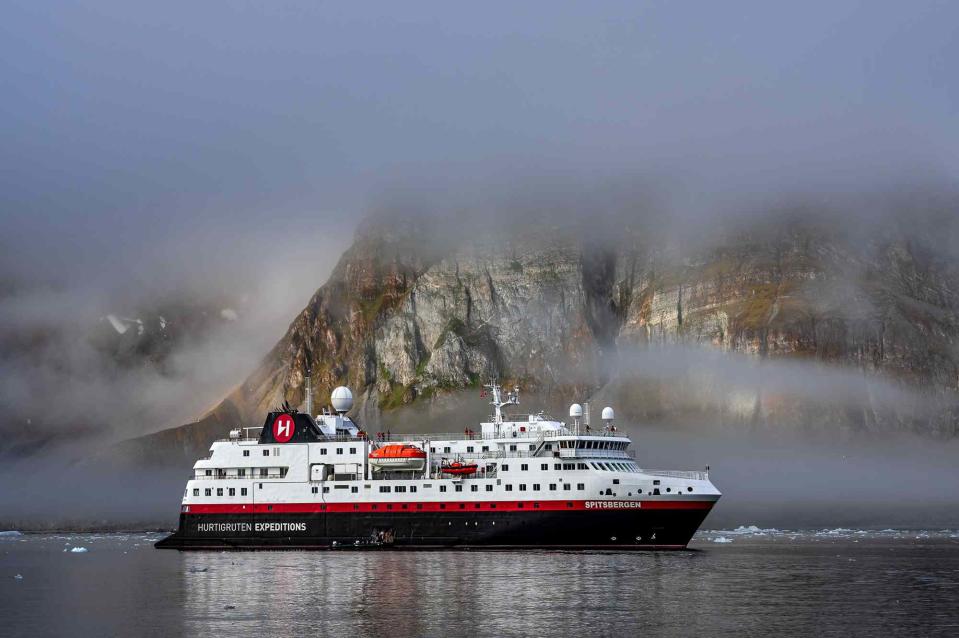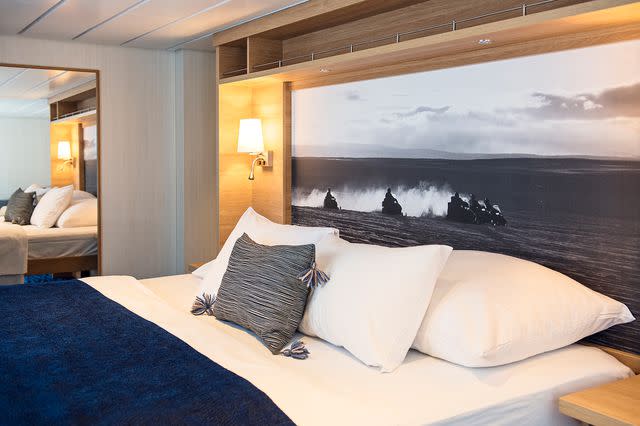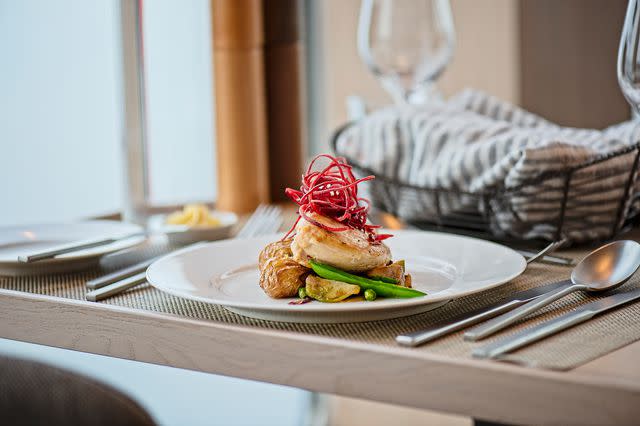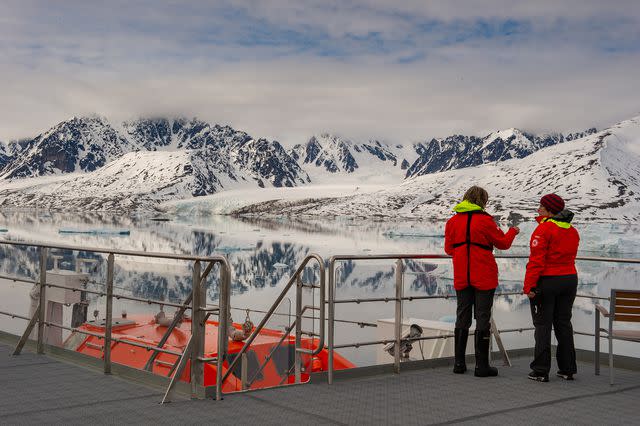This New, Once-in-a-lifetime Cruise Sails Along the Incredible Coast of West Africa — Here's What It's Like on Board
Hurtigruten Expeditions recently became the only international cruise line to sail the West African coast, and we were among the first on board.

Courtesy of Jan Hvizdal/Hurtigruten Expeditions
Editor’s note: Because of political unrest in Guinea-Bissau, the cruise our reporter sailed on was cut short by three days, bypassing the Bissagos.
Until a month ago, I’d never set foot on the African continent. I assumed that when I finally did, it’d be on safari or on a trip to a major African city — say, Johannesburg or Accra, Ghana. Instead, my first trip to Africa was on an adventure cruise with Hurtigruten Expeditions – sailing roundtrip from Dakar, Senegal to Cape Verde, Guinea-Bissau, and The Gambia.
The trip was one of the first West African journeys for the Oslo, Norway-based cruise line. My sailing, aboard the 220-passenger MS Spitsbergen had only 58 travelers on board. Within a few days of leaving Dakar, I was on waving terms with many of the other (older, mostly European) guests, and after a few excursions together, our cruise buddy status was cemented.
I’d start my day as I do at home: with a sunrise workout, either in the ship’s fitness room or running on the top deck, deck eight. (I use the term “running” loosely, because there’s no track and the deck is very small.) But between the sea air and the rising sun, it was a refreshing way to kick off a sea day, especially when I could join the gym's stretch classes, held each morning, for a welcome cool down.
Breakfast in Spitsbergen’s only restaurant, Aune, was a buffet affair, heavy on European favorites including yogurt, muesli, and varieties of smoked fish. It was fuel for a sea day that might be filled with art class (I particularly enjoyed painting my ship-supplied metal water bottle); photography tutorials; nautical knot–tying demonstrations; or Q&A sessions with the captain and his officers. Science-loving passengers could always find something to do in the ship’s Science Center, where staff gave lectures about the area’s marine life. You could also join them outside for daily wildlife watches, keeping an eye out for dolphins, flying fish, and native birds.
Beyond these activities (and a catalog of on-demand, in-cabin movies), sea days on Spitsbergen require making your own entertainment. Get lost in a book (there’s a small, multi-language library on board); sweat it out in the ocean-view sauna, or just find a window seat and watch the water go by. Because it is designed to cruise colder climates, Spitsbergen lacks some of the amenities you’d want on a warm-weather cruise (there’s no pool, for example; just a pair of tiny hot tubs at the ship’s aft). And because this is true expedition cruising, there are no onboard diversions such as a casino, nightly shows, a movie theater, or duty-free shops. As on all expedition cruises, it’s the destinations that are the real draw.
In that respect, this West African cruise delivered – and then some. In Dakar, visiting Gorée Island, a former trading post for enslaved Africans — was an impactful start to our journey. Port excursions that followed — clearly designed to immerse guests in the local culture and landscape — included village and museum visits; city walking tours; and hiking. The trek I chose on Cape Verde’s Fogo Island took me across miles of jet-black ash to the crater of the active volcano Pico de Fogo.
Inspired to see West Africa by sea? Here, my review of Hurtigruten's MS Spitsbergen and all the details on where it sails.
MS Spitsbergen, Hurtigruten Expeditions
The Spitsbergen’s 110 Scandinavian-style cabins are modern and minimal, and all of them have a heated bathroom floor.
A West African chef prepares regional specialties for lunch and dinner every day at the ship's restaurant, Aune.
The interactive onboard science center (staffed on our cruise by an ornithologist, marine scientist, and cetacean researcher) is a bonus for passengers interested in the wildlife you’ll encounter during the cruise.
The Staterooms

Courtesy of Agurtxane Concellon/Hurtigruten Expeditions
On decks four, six, and seven, Spitsbergen’s 110 staterooms are sold in six categories, ranging from the entry-level Polar Inside rooms to the six Expedition Suites, which are the only cabins with balconies. The smallest Polar Inside room is 95 square feet, while the largest cabin, the Owner's Suite, clocks in at 355 square feet. Interior cabins can be surprisingly spacious (some as large as the Arctic Superior cabins, along the ship's exterior), except for those on deck four, which have twin beds, one of which pulls down from the wall. The Scandinavian design uses an appropriately sea-themed palette of blond woods, cream walls, and blue accents. In most rooms, furniture is minimal (just a chair and ottoman) and photography of the destinations Spitsbergen sails on the walls. Bathrooms have walk-in showers and heated floors — a surprisingly welcome post-shower perk, even on an African sailing.
Bars and Restaurants
Deck five’s Aune is the ship’s only restaurant, serving a buffet-style breakfast, lunch, and dinner. The spread is open for just 90 minutes, so late-sleepers and leisurely diners, beware. On West African sailings, a local chef prepares regional dishes (I loved the jollof rice from Nigeria) for lunch and dinner. Wine, beer, and soft drinks are complimentary with meals, but are charged at an additional fee outside meal times.

Courtesy of Agurtxane Concellon/Hurtigruten Expeditions
There’s no room service on Spitsbergen, but guests may call and order from a small to-go menu of breakfast sandwiches. At dinnertime, there’s selection of to-go burgers, which you must order and pick up in person at the restaurant, and then enjoy elsewhere because to-go meals aren’t permitted at Aune.
The Explorer Bar on deck five offers Continental breakfast from 6:30 a.m. until breakfast starts at Aune at 7:30 a.m. There are cookies, coffee, and tea available all day; and a cake of the day is served at 3 p.m.. The bar is busiest after dinner, as guests congregate here for the nightly presentation about the next day’s port and excursions.
Where Spitsbergen Sails
Hurtigruten’s intends to sail five West Africa cruises each year, from October through December. The 12-day trips travel roundtrip from Dakar, Senegal, to the islands of Cape Verde; Guinea-Bissau’s Bissagos Islands; and the Gambia (from $6,578). This route debuted in 2023, and, at the time of publish, Hurtigruten was the only line with a ship based in Dakar and the only international cruise line operating expedition cruises along the West African coast. In the summer months, Spitsbergen cruises up and down the Norwegian coast to and from Svalbard; its spring itineraries are in the British Isles.

Courtesy of Dr. Verena Meraldi/Hurtigruten Expeditions
Shore Excursions
Your cruise fare includes a complimentary shore excursion (usually an island or city tour) in each port. Other outings (from three to eight hours in length; priced from €85) include hikes and visits to museums and local villages.
On day one, in Dakar, the excursion to nearby Gorée Island – a former island trading post from which more than 20 million Africans were shipped into European slavery – is a sobering but necessary start to the cruise, driving home the enduring impact of slavery on West Africa and the world.
The cruise then continues to three islands in the archipelago of Cape Verde: Santiago, Santo Antão, and Fogo. If you’re an active traveler who is comfortable hiking without shade, I would definitively recommend the hike to the crater of Fogo’s still-active volcano, Pico de Fogo. It’s roughly a two-hour ascent over jet-black lava from the most recent eruption in 2014, and the views of the vast and austere lava fields below are worth every bead of sweat.
The little-visited Bissagos Islands in Guinea-Bissau are next on the itinerary. However, the particular islands you visit depend on prevailing sea conditions, so the exact details of the excursion (there’s only one, and it’s included) aren’t known until the day before. Excursions in the Bissagos, via small boats and kayaks, take guests into forests, wetlands, and mangroves, where you may encounter hippos, monitor lizards, and native birds.
At the final port, Gambia’s capital, Banjul, most passengers I traveled with chose the excursion to the village where Kunta Kinteh (from American author Alex Haley’s novel "Roots") was born.
Amenities and Entertainment
Every ship in the Hurtigruten fleet has an interactive science center on board, and Spitsbergen is no exception. The centers are staffed by a team that, on our voyage, included an ornithologist, marine scientist, and cetacean researcher, who lead various Citizen Science programs, such as whale-, wildlife-, and cloud-watching.

Courtesy of Madis Sarglepp/Hurtigruten Expeditions
Beyond the science center, activities range from stretching class to nautical knot tutorials (French and German interpreters are on hand to translate during all activities). During the extended port call in Banjul, a Gambian dance and drumming troupe performs on board, but don’t expect the Broadway-style shows typical of U.S.-based cruise lines. There’s no evening entertainment beyond the nightly port briefing, offered in the Explorer Bar with live interpretation in French and German via headset.
Family-friendly Offerings
Hurtigruten discourages bringing children under 12 on its West Africa sailings. There’s no dedicated kids' programming on board, and the “wet landings” the ship makes in the Bissagos Islands (which require tendering from the ship in a Zodiac boat, disembarking into waist-deep water, and wading to shore) aren't ideal for young travelers. These cruises are more suitable for older kids – particularly those interested in science, birds, or marine life.
Accessibility
Spitsbergen, Hurtigruten’s smallest ship, has one wheelchair accessible cabin, an Arctic Superior cabin on deck six.
For more Travel & Leisure news, make sure to sign up for our newsletter!
Read the original article on Travel & Leisure.

